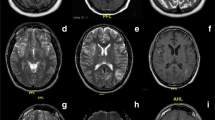Abstract
Toddlers are more prone to develop severe and extrapulmonary tuberculosis (TB) than older children. This is partially explained by differences in the immune response. Early and specific diagnosis is essential to start adequate treatment, especially if the central nervous system (CNS) is involved. The lack of sputum production and inherent dangers or impossibility of sampling CNS lesions may delay diagnosis. In addition, the magnetic resonance imaging (MRI) features of TB abscesses are non-specific and may mimic abscesses of other infectious etiology. 1H-magnetic resonance spectroscopy (1H-MRS) may increase specificity of diagnosis by identifying lipids within the lesions that are considered characteristic for TB. Therefore, we studied four children with presumable CNS-TB with MRI and 1H-MRS. In vivo and in vitro 1H-MRS showed elevated lipid peaks within the TB lesions. Conclusion: 1H-MRS allows to non-invasively identifying TB with high specificity and may allow early installment of targeted antimicrobial treatment.





Similar content being viewed by others
References
Barry CE 3rd, Boshoff HI, Dartois V, Dick T, Ehrt S, Flynn J, Schnappinger D, Wilkinson RJ, Young D (2009) The spectrum of latent tuberculosis: rethinking the biology and intervention strategies. Nat Rev Microbiol 7:845–855
Chintu C, Mudenda V, Lucas S, Nunn A, Lishimpi K, Maswahu D, Kasolo F, Mwaba P, Bhat G, Terunuma H, Zumla A (2002) Lung diseases at necropsy in African children dying from respiratory illnesses: a descriptive necropsy study. Lancet 360:985–990
Dye C (2006) Global epidemiology of tuberculosis. Lancet 367:938–940
Gupta RK, Vatsal DK, Husain N, Chawla S, Prasad KN, Roy R, Kumar R, Jha D, Husain M (2001) Differentiation of tuberculous from pyogenic brain abscesses with in vivo proton MR spectroscopy and magnetization transfer MR imaging. AJNR Am J Neuroradiol 22:1503–1509
Haustein T, Ridout DA, Hartley JC, Thaker U, Shingadia D, Klein NJ, Novelli V, Dixon GL (2009) The likelihood of an indeterminate test result from a whole-blood interferon-gamma release assay for the diagnosis of Mycobacterium tuberculosis infection in children correlates with age and immune status. Pediatr Infect Dis J 28:669–673
Karakousis PC, Bishai WR, Dorman SE (2004) Mycobacterium tuberculosis cell envelope lipids and the host immune response. Cell Microbiol 6:105–116
Kaufmann SH (2006) Envisioning future strategies for vaccination against tuberculosis. Nat Rev Immunol 6:699–704
Kaufmann SH (2010) Future vaccination strategies against tuberculosis: thinking outside the box. Immunity 33:567–577
Lonnroth K, Castro KG, Chakaya JM, Chauhan LS, Floyd K, Glaziou P, Raviglione MC (2010) Tuberculosis control and elimination 2010-50: cure, care, and social development. Lancet 375:1814–1829
Luthra G, Parihar A, Nath K, Jaiswal S, Prasad KN, Husain N, Husain M, Singh S, Behari S, Gupta RK (2007) Comparative evaluation of fungal, tubercular, and pyogenic brain abscesses with conventional and diffusion MR imaging and proton MR spectroscopy. AJNR Am J Neuroradiol 28:1332–1338
Marais BJ, Schaaf HS (2010) Childhood tuberculosis: an emerging and previously neglected problem. Infect Dis Clin North Am 24:727–749
Mishra AM, Gupta RK, Jaggi RS, Reddy JS, Jha DK, Husain N, Prasad KN, Behari S, Husain M (2004) Role of diffusion-weighted imaging and in vivo proton magnetic resonance spectroscopy in the differential diagnosis of ring-enhancing intracranial cystic mass lesions. J Comput Assist Tomogr 28:540–547
Mitchison DA, Fourie PB (2010) The near future: improving the activity of rifamycins and pyrazinamide. Tuberc (Edinb) 90:177–181
Newton SM, Brent AJ, Anderson S, Whittaker E, Kampmann B (2008) Paediatric tuberculosis. Lancet Infect Dis 8:498–510
Raviglione MC, Smith IM (2007) XDR tuberculosis—implications for global public health. N Engl J Med 356:656–659
Russell DG (2007) Who puts the tubercle in tuberculosis? Nat Rev Microbiol 5:39–47
Semlali S, El Kharras A, Mahi M, Hsaini Y, Benameur M, Aziz N, Chaouir S, Akjouj S (2008) Imaging features of CNS tuberculosis. J Radiol 89:209–220
Stricker T, Willi UV, Pfyffer GE, Nadal D (1996) A school-girl with constipation. Lancet 348:306
Swaminathan S, Rekha B (2010) Pediatric tuberculosis: global overview and challenges. Clin Infect Dis 50(Suppl 3):S184–S194
Acknowledgments
This study was made possible by the Kantha Bopha Foundation that is supported by donations mainly from Swiss people. The authors thank Dr. Ianina Scheer, Prof. Thierry .A. Huisman, and Prof. Beat Steinmann for helpful discussions.
Author information
Authors and Affiliations
Corresponding author
Rights and permissions
About this article
Cite this article
Santy, K., Nan, P., Chantana, Y. et al. The diagnosis of brain tuberculoma by 1H-magnetic resonance spectroscopy. Eur J Pediatr 170, 379–387 (2011). https://doi.org/10.1007/s00431-011-1408-7
Received:
Revised:
Accepted:
Published:
Issue Date:
DOI: https://doi.org/10.1007/s00431-011-1408-7




